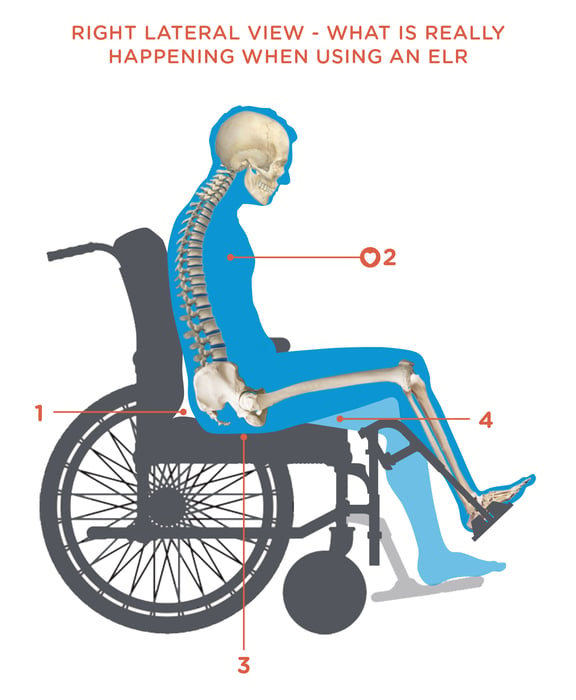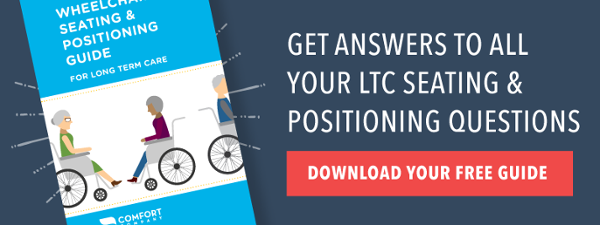Part 20 in our LTC Seating & Positioning series intended to shed some light on the mystery of seating and positioning in the LTC setting. See the rest of the blog posts in the following links: Part 1 (Best Wheelchair Options in LTC), Part 2 (Posture Problems), Part 3 (Posterior Pelvic Tilt), Part 4 (Anterior Pelvic Tilt), Part 5 (Pelvic Obliquity), Part 6 (Pelvic Rotation), Part 7 (Fixed vs Flexible Postural Abnormalities), Part 8 (Windswept Posture), Part 9 (Incorrect Seating Dimensions), Part 10 (Issues with Current Wheelchair System: Seat-to-Floor-Height), Part 11 (Issues with Current Wheelchair System: Back Support), Part 12 (Issues with Current Wheelchair System: Legrest), Part 13 (Issues with Current Wheelchair System: Armrest), Part 14 (Issues with Current Wheelchair System: Head Support), Part 15 (Why is wheelchair seating & positioning important for our residents?), Part 16 (How to Measure: Step of a Seating Eval), Part 17 (How to Measure: Specific Measurements), Part 18 (How to Choose a Cushion in Long Term Care), Part 19 (How to choose a specialized back support in Long Term Care)
If you're a frequent visitor to this blog, you probably remember our posts in the past about the myths surrounding the use of Elevating Leg Rests (ELRs) in the Long Term Care setting. The misuse of Elevating Leg Rests is so pervasive in the LTC industry that it's worth going over yet again. Let's begin!
As we age, many changes occur to our muscles, bones, and joints. Our body becomes very rigid –like an ironing board – instead of moving in compartmentalized units. This can be due to the following changes:
Muscles
- Muscle fibers reduce in quantity and shrink in size
- Lost muscle tissue is regenerated more slowly, replaced with tougher, more fibrous tissue
- Muscles shorten and become more rigid
Joints
- Cartilage decreases between bones at the joint and allows for more bone-on-bone contact
- Joints lose synovial fluid, becoming stiffer and less flexible
- Ligaments shorten and lose flexibility
Bones
- Vertebrae lose fluid and disk space between vertebrae become thinner, causing our trunk to shorten
- Loss of minerals in the vertebrae cause compression and curvature of the spine
- Loss of calcium and minerals make our bones more brittle
When we are positioning a resident, we do not want to do anything to the wheelchair that will increase unwanted pressure or stress on the already compromised muscles and skeleton of our elderly resident.
In the LTC setting, we purchase mostly K0001-K0004 manual wheelchairs that don’t provide a whole lot of adjustability (with the exception of the K0004). The sales representative always asks if we would like standard leg rests or ELRs. Most of us are under the impression that ELRs are the better option. Facilities push them on us because they “help edema,” “keep the hips back in the chair,” “decrease pressure on the pelvis,” and “assist with LE alignment.” So ELRs are the best option, right?
The answer to that question is NO! Below we break down some common myths about Elevating Leg Rests for Wheelchair that you need absolute clarification on to help you understand why standard leg rests are usually the better option.
THE MYTHS

1. ELRs keep hips back in chair: WRONG!
- ELRs do just the opposite!
- When we elevate the legs, we pull on the already tightened hamstrings of the resident.
- The shortened hamstrings cause a greater pull on the pelvis, bringing the pelvis into a posterior pelvic tilt.
- The resident begins to slide forward out of the chair, the exact opposite of keeping the hips back in the chair.
2. ELRs decrease edema: WRONG!
- Contrary to popular belief, ELRs on K0001-K0004 MWCs—the type typically seen in a nursing home—unfortunately CANNOT reduce edema naturally.
- In order to decrease edema, the legs must be 30 cm above heart level. The only way to achieve that degree of elevations with an ELR is when used in combination with tilt and recline, often seen in power chairs.
- ELRs on a manual chair actually decrease optimal circulation by cutting off blood flow at the groin area and inhibiting flow causing lower extremity edema.
3. ELRs decrease pressure on the pelvis: WRONG!
- ELRs actually position the pelvis in a posterior pelvic tilt.
- The forced posterior pelvic tilt increases pressure on the bony prominences of the ITs, sacrum, and coccyx.
- Wound development risk is increased in those areas.
- Elevating the legrest promotes knee flexion, leading to decreased femoral contact, shifting the pressure back onto the ITs and sacrum/coccyx.
4. ELRs help with Lower Extremity alignment: WRONG!
- ELRs prevent full femoral contact with the seat surface.
- Since less of the leg is making contact with the seat surface, it is easier for the leg to internally/externally rotate or abduct/adduct.
- Legs then fall off legrests more easily.
- Windswept posture is more prevalent.
- ELRs promote flexion of knees, hips, and ankles, incrasing risk of contractures at those joints.
AVOID THE USE OF ELRs as much as possible for optimal positioning in a K0001-K0004 manual wheelchair. Our compromised muscles and skeleton cannot withstand the less than desirable position of the pelvis and LEs that ELRs create especially when elevated at higher settings. Hopefully I have helped you to see why ELRS are NOT the best choice for our nursing home resident. Check back next week when we discuss when to add wheelchair accessories in Long Term Care.

Ana Endsjo, MOTR/L, CLT
Clinical Education Manager LTC Division
Ana Endsjo has worked as an occupational therapist since 2001 in a variety of treatment settings. She has mainly worked with the geriatric population, dedicated to the betterment of the treatment of the elderly in LTC centers. Her focus has been on seating and positioning and contracture management of the nursing home resident. With this experience, her hope is to guide other therapists, rehab directors, nurses, and administrators through educational guides, blogs, webinars, and live courses in her role as Clinical Education Manager for the long term care division.

